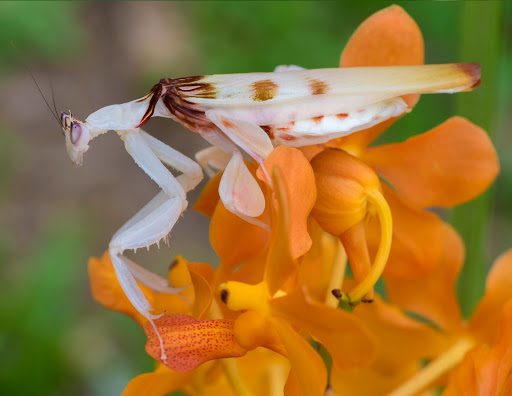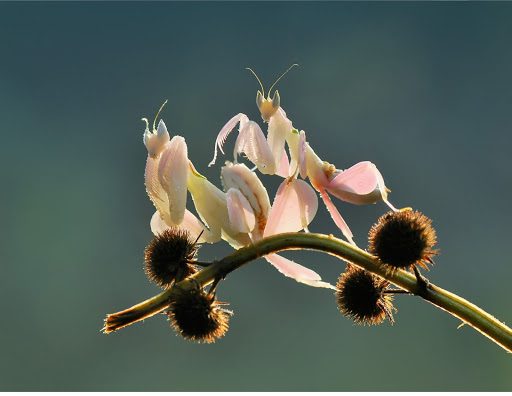This week we’re taking a look at the orchid mantis, a ruthless little insect that quite remarkably resembles an orchid bloom.
Orchid mantises are fascinating because of their unique ability to change colors and camouflage to ambush their prey. They’re known for their ability to look like flowers and for their rather ruthless hunting strategies. These carnivorous insects gobble up other bugs and sometimes even their own mates.
Below, we answer your 9 most common questions about the orchid mantis so you can get to know these exotic, rare insects a bit more. First, we’ll tackle the basics, and then we’ll move on to some more specific questions. Some of the answers might surprise you.
And, who knows, maybe you’ll even become an orchid mantis enthusiast—there are many hobbyists all over the world.
Question #1: What is an orchid mantis?
An orchid mantis is scientifically known as Hymenopus coronatus. The species is a variety of praying mantis that resembles an orchid bloom. Each mantis has bright color patterns and ornately lobed legs.
Contrary to popular belief, the orchid mantis does not live in or feast on orchid flowers. Instead, it uses its resemblance to the orchid flower to attract and kill its prey.

Question #2: Where do they live?
The orchid mantis is native to the rainforests of southeast Asia. They thrive in the humid, lush rainforest biome, which many hobbyists recreate to keep orchid mantises as pets. Although it’s easy to assume that orchid mantises live in orchid groves, they don’t favor orchid plants. But they do resemble orchid blooms.
Question #3: When were they discovered?
British explorer James Hingsley recorded an orchid mantis sighting in his journal in the late 19th century when he was on an expedition in Indonesia. Though Hingsley surely wasn’t the first to encounter the unique bug, his account is one of the earliest known records.
In his account, James Hingsley stumbled across a red flower that trapped a butterfly and ate it, just like a spider would have trapped its prey to devour it. Of course, Kingsley was witnessing an orchid mantis eating a butterfly, but he was deceived by the mantis’s camouflage.
Question #4: Do they look like any orchid in particular?
As far as researchers and scholars can tell, the orchid mantis doesn’t resemble any one particular orchid variety. This may be deliberate since it allows the orchid mantis to attract many types of insects rather than one in particular.
Question #5: What are the features of an orchid mantis?
The orchid mantis resembles an ornate flower, like an orchid. It has a white, semi-translucent body, long limbs, and lobes on its legs that resemble flower petals.
They come in a variety of colors, such as pink, orange, yellow, green, or brown. Some mantises have dark sections on their abdomens that give the impression of a budding flower.
Aside from their showy colors and striking resemblance to orchid blooms, orchid mantises look a lot like other mantis species. They have four legs, two sets of wings, and two protruding eyes that sit on top of their heads.

A female orchid mantis is about 6 to 7 centimeters long and has 6 or 7 body segments. A male orchid mantis, on the other hand, grows to be only about 2 to 3 centimeters long and has about 8 body segments.
Question #6: Are orchid mantises aggressive?
Orchid mantises are aggressive insects. Despite their flowery colors, they catch their prey by snatching it out of the air with their front legs and they devour it mercilessly.
Female orchid mantises are known to be more aggressive than males. A female orchid mantis will eat its male counterpart after copulation or when it’s hungry. This kind of cannibalism is made easier by the fact that female mantises are more than double the size of males.
Question #7: Do orchid mantises have teeth?
Yes, orchid mantises have tiny teeth that allow them to kill their prey and eat it quickly. They also have spiky hairs on their forelegs to help them catch and eat large insects, sometimes ones that are two or three times their size.
The good news is that their bites are not harmful to humans. Orchid mantises don’t carry venom or poison, so their bites simply cause skin irritations to humans.
Question #8: What do they eat?
Typically, orchid mantises eat other insects. They feed on bees, butterflies, moths, crickets, flies, and beetles. Some orchid mantises, however, attack bigger creatures like mice, frogs, lizards, and scorpions.
When you consider the size of an orchid mantis next to a mouse or frog, it’s quite remarkable that the orchid mantis has the ability to kill prey up to triple its own size.
Question #9: Do they change color?
Yes, orchid mantises can change color to camouflage themselves. Their color changes are triggered when they detect something new in the environment.
Pink is the primary color of most orchid mantises, but they also have patterns of white, yellow, orange, and purple. They can turn themselves brown if they’re hiding in brush or foliage.
Join Our Orchid Lovers Facebook Community
We’ve got a confession. We’re obsessed with all things orchid—caring for orchids, growing orchids, populating orchids, and learning about orchid history.
And we can prove it. Check out our previous articles on the importance of orchids across cultures, how to choose the perfect orchid to give as a gift, and how to grow orchids if you’re a beginner.
And, if you’re like us and you want to join a community of orchid lovers, pop in to our Facebook community where you can ask questions, share photos, and tell stories of your own orchid-growing experiences.



